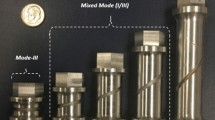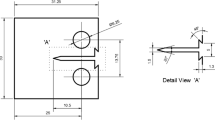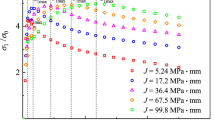Abstract
In this work, a new hybrid computational and experimental method is proposed which can be used to extract the dynamic fracture parameters in engineering materials at high loading rate. Torsional Hopkinson Bar is used to load an aluminum spiral notched specimen in mode I fracture configuration at different loading rate. A tubular specimen with spiral crack at 45° made of Aluminum 6061-T6, was used for the experiment. Using the experimental measured torque value as input computation analysis is performed to identify the dynamic initiation fracture toughness of the material. For the computational analysis, finite element is implemented in Abaqus. The result show that the dynamic stress intensity factor is loading rate sensitive, giving \( {K}_{Ic}^d\cong \left(1.2\mp 0.2\right){K}_{Ic}. \) The crack initiation time is also influenced by the rate of loading.
Access provided by CONRICYT-eBooks. Download conference paper PDF
Similar content being viewed by others
Keywords
24.1 Introduction
Intermediate and high strain rate properties of materials are a subject of interest in the mechanical researcher community for long time. These types of loading commonly exists in most materials used for day-to-day activities. The behavior of most engineering materials changes with strain rate [1]. So far, the mechanics community have developed computational and experimental methods to identify the behavior and properties of materials with a wide range of strain rates. Fracture mechanics is one branch of solid mechanics which started with the work of Griffith in 1920 [2]. Today, there are few successful methods to estimate the fracture toughness of materials, K Ic , at quasi-static condition. On the other hand, determining the dynamic fracture initiation toughness of materials under dynamic loading conditions is still a great challenge. Currently, there is no a single standard method to identify the dynamic fracture toughness of materials, though there are many mathematical models and analysis for dynamic fracture of materials [3,4,5,6].
Recently, a new approach has proposed to evaluate the quasi-static and the dynamic fracture toughness of materials by loading under pure torsion load [7,8,9,10]. One of the main challenge with the technique is, there is no a closed form equation that can be used to extract fracture parameters directly from experimental results. Instead, a combined experimental and numerical method is adapted to measure and extract the fracture initiation toughness of materials.
In this work, a recent result on the dynamic fracture toughness \( {KI}_C^d \) , of aluminum obtained from the proposed method is presented. An aluminum specimen with 45o spiral crack was loaded under pure torsion using a torsional split Hopkinson apparatus. The torsional load creates a mode I fracture loading on the crack line that is pre-notched at 45o. The torque measured in the experiment was used as input for FE model performed in ABAQUS and the fracture parameters were extracted.
24.2 Experimental Setup
A Torsional Split Hopkinson Bar (TSHB) shown in Fig. 24.1, is used to generate dynamic torsional load. The details of the device and its working principle are available in literature [11, 12], however for completeness, the overview of the details will be presented.
The TSHB apparatus consists of incident and transmitter bars made of Aluminum 7075-T651, clamping mechanism and a torque pulley. The entire system is supported on an I-beam frame. The clamp system is used to hold the input bar at a specified position and store torsional elastic energy between the clamp and the rotary actuator. The rotary actuator determines how much elastic wave can be generated and hence determines the strain rate and applied stress on the specimen. In order to generate the dynamic torsional load, the clamp system will be released suddenly, allowing the stored torsional load to propagate along the bar through the specimen. Strain gages positioned at a mid-length of the incident and transmitter bars will record the incident, transmitted and reflected strain waves. In addition, 3D digital image correlation is used to measure the full field deformation of the specimen directly.
A tubular Aluminum 6061-T6 specimen with a 45o spiral crack shown in Fig. 24.1 was used for the experiment. The specimen has outside diameter of 18.5 mm, inside diameter of 12.7 mm and gage length of 60 mm. A spiral crack was made on the outer surface of the tube by using 4-axis CNC machine with a crack depth of 1.9 mm, crack ligament of 1 mm, and 45o with respect to the specimen axis
24.3 3D Digital Image Correlation
3D–Digital image correlation was used to measure full field deformation near the crack on the curved surface. Two high-speed cameras, SAX2 by Photon Inc., were used at a frame rate of 100,000 frames/sec. The region of interest around the crack face was speckled with white and black flat paint, which gave minimally reflective finish once dried as shown Fig. 24.2. This method will enable us to measure the deformation and strain on the specimen directly. Measuring the crack initiation time accurately has been difficult in dynamic fracture experiment [13]. The displacement and strain fields obtained for the DIC are used to measure the crack initiation time accurately.
24.4 Finite Element Setup
All the stress and strain waves measured experimentally were measured on the outer surface of the specimen and it is difficult to measure the local stress close to the crack tip in this type of specimen. So, the Finite element analysis was used to get the stress and strain near the crack tip and extract the fracture parameters. A three-dimensional element, C3D20H, was used as shown in Fig. 24.3. Since the torsional load is constant along the gage length, only the quarter of the gage length was modeled with 90° spiral crack to reduce the number of elements. The modeling parameters and information such as, boundary conditions, number of elements, element type, etc. are available for an interested reader with extensive details in Fahem 2016 [8].
24.5 Results and Discussion
Typical strain signals measured by the strain gages attached on the bars are shown in Fig. 24.4. Incident, reflected and transmitted strain waves are extracted and shown in Fig. 24.5.
The strain signals shown in Fig. 24.5. are used to calculate the torque applied on the specimen by using one-dimensional wave equations shown in Eq. (24.1). The effective impulse torque used in the analysis is the average of the torque on a both side of the specimen given by Eq. (24.1).
The torque calculated from the incident signals using Eq. (24.1) are shown in Fig. 24.6.
Using the torque value presented in Fig. 24.6, as input data, the fracture parameters are extracted using FM model discussed above. Overall, as shown in Fig. 24.7, the shear stress distribution in the mid layer of a cross section area is non-liner. Also, the stress is symmetric about a line connecting the bar center with the crack tip.
Figures 24.8 and 24.9 shows the stress intensity factor for different experiment conducted at different rate of loading. As clearly shown, the stress intensity factor is strain rate sensitive, increasing with loading rate increase.
From the DIC results and the DSIF’s trend, the Dynamic Initiation toughness was identified for each loading rate. In general, the experiments show that the dynamic initiation fracture toughness is higher compared with the quasi-static value, \( {K}_{Ic}^d\cong \left(1.2\mp 0.2\right){K}_{Ic}. \) The time of initiation (t f ) is influenced by the rate of loading too, as shown in Table 24.1.
24.6 Conclusion
A dynamic mode I fracture of Aluminum 6061-T6 is investigated using a Torsional Hopkinson Bar and spiral notch specimen. The torque applied on the specimen is measured by using the well-known wave equation in a Hopkinson Bar. The torque is then used as input for the FM model. The fracture parameters are extracted directly from the FE model. A digital image correlation method was used to measure a full-field displacement and identify the fracture time It was demonstrated that the proposed hybrid numerical-experimental approach is visible to measure the mode I fracture initiation toughness of materials under dynamic loading conditions. It was noticed that the aluminum material used in this work was rate sensitive, showing high stress intensity factor at a higher loading rate.
References
Meyers, M.A.: Dynamic Behavior of Materials. Wiley, New York (1994)
Griffith, A.A.: The phenomena of rupture and flow in solids. Phil. Trans. Roy. Soc. London. Ser. A. 221, 163–198 (1920)
Knauss, W.G.: CI of T, Williams ML (Universit. of P (1985) Dynamic Fracture. doi: 10.1016/B978-008044352-2/50011-9
Freund L.B.: (Brown U). Dynamic Fracture Mechanics. Cambridge University Press (1990). doi: 10.1007/s13398-014-0173-7.2
Morozov, N., Petrov, Y.: Dynamics of Fractture. Springer (2000). doi: 10.1007/978-3-7091-1777-4
Ravi-Chandar, K.: Dynamic Fracture. University of Texas, Austin (2004). doi:10.1016/B978-008044352-2/50011-9
Wang J-A., Oak R., Lin K.C Oak R.: Fracture toughness determination using spiral-grooved cylindrical specimen and pure torsional loading. United States Pat Appl Publ. doi: US2010/0311130Al
Fahem, A.F., Kidane, A.: A general approach to evaluate the dynamic fracture toughness of materials. Strain. 1, 229–236 (2016). doi:10.1007/978-1-4614-0216-9
Kidane, A., Wang J-A: New method for dynamic fracture toughness determination using torsion hopkinson pressure bar. Conf Proc Soc Exp Mech Ser. (2013). doi:10.1007/978-1-4614-4238-7
Wang, J.-A., Kidane, A.: A new approach to determine the quasi-static and dynamic fracture toughness of engineering materials, dynamic behavior of materials. Proc Soc Exp Mech Ser. 1, 545–551 (2013)
Weerasooriya, T.: THE MTL Torsional Split-Hopkinson Bar, p. 32. MTL TR 90-27, U.S. Army Materials Technology Laboratory, Watertown (1990)
Naik, N.K., Asmelash, A., Kavala, V.R., Ch, V.: Interlaminar shear properties of polymer matrix composites : strain rate effect. Mech Mater. 39, 1043–1052 (2007). doi:10.1016/j.mechmat.2007.05.0
Kidane, Shukla, A.: Quasi-static and dynamic fracture initiation toughness of Ti/TiB layered functionally graded material under thermo-mechanical loading. Eng. Frac. Mec. 77, 479–491 (2010)
Author information
Authors and Affiliations
Corresponding author
Editor information
Editors and Affiliations
Rights and permissions
Copyright information
© 2018 The Society for Experimental Mechanics, Inc.
About this paper
Cite this paper
Fahem, A.F., Kidane, A. (2018). Hybrid Computational and Experimental Approach to Identify the Dynamic Initiation Fracture Toughness at High Loading Rate. In: Kimberley, J., Lamberson, L., Mates, S. (eds) Dynamic Behavior of Materials, Volume 1. Conference Proceedings of the Society for Experimental Mechanics Series. Springer, Cham. https://doi.org/10.1007/978-3-319-62956-8_24
Download citation
DOI: https://doi.org/10.1007/978-3-319-62956-8_24
Published:
Publisher Name: Springer, Cham
Print ISBN: 978-3-319-62955-1
Online ISBN: 978-3-319-62956-8
eBook Packages: EngineeringEngineering (R0)













